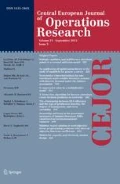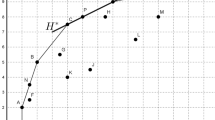Abstract
Data envelopment analysis (DEA) is an approach for measuring the relative efficiency of peer decision making units that have multiple inputs and outputs. In most practical applications of DEA presented in the literature, the presented models assume that outputs are produced perfectly (see Charnes et al. Eur J Oper Res 2:429–444, 1978). However, in many real situations, some outputs are imperfect and they need to be repaired. This paper develops a DEA approach for measuring the efficiency of decision processes which can be divided into two interdependent stages, arranged in series. The novelty of the proposed approach is the existence of perfect and imperfect outputs in a two-stage decision process. This application of two-stage process involves shared resources and the paper gives a best split of these shared resources between two stages. The case of Iranian car representatives is presented.
Similar content being viewed by others
References
Amirteimoori A, Kordrostami S (2010) Multi-period efficiency analysis in data envelopment analysis. Int J Math Oper Res 2(1): 113–128
Banker RD, Charnes A, Cooper WW (1984) Some models for estimating technical and scale inefficiencies in DEA. Manag Sci 30(9): 1078–1092
Charnes A, Cooper WW (1962) Programming with linear fractional function. Nav Res Logist Quarterly 9: 181–186
Charnes A, Cooper WW, Rhodes E (1978) Measuring the efficiency of decision making units. Eur J Oper Res 2: 429–444
Charnes A, Cooper WW, Lewin A, Seiford LM (1994) Data envelopment analysis: theory, methodology and applications. Kluwer Academic Publishers, Boston
Chen Y, Liang L, Zhu J (2009a) Equivalence in two-stage DEA approaches. Eur J Oper Res 193: 600–604
Chen Y, Cook WD, Li N, Zhu J (2009b) Additive efficiency decomposition in two-stage DEA. Eur J Oper Res 196(3): 1170–1176
Chen Y, Zhu J (2004) Measuring information technology’s indirect impact on firm performance. Inf Technol Manag J 5(1–2): 9–22
Cooper WW, Seiford LM, Tone K (2006) Introduction to data envelopment analysis and its uses. Springer Publisher, New York
Golany B, Hackman ST, Passy U (2006) An efficiency measurement framework for multi-stage production system. Annal Oper Res 145: 51–68
Hoopes B, Triantis KP, Partangel N (2000) The relationship between process and manufacturing plant performance: A goal programming approach. Int J Oper Quant Manag 6: 287–310
Kao C (2009) Efficiency measurement for parallel production systems. Eur J Oper Res 196(3): 1107–1112
Seiford LM, Zhu J (1999) Profitability and marketability of the top 55 US commercial banks. Manag Sci 45(9): 1270–1288
Zhu J (2003) Quantitative models for performance evaluation and benchmarking: data envelopment analysis with spreadsheets. Kluwer Academic Publishers, Boston
Author information
Authors and Affiliations
Corresponding author
Rights and permissions
About this article
Cite this article
Amirteimoori, A. A DEA two-stage decision processes with shared resources. Cent Eur J Oper Res 21, 141–151 (2013). https://doi.org/10.1007/s10100-011-0218-3
Published:
Issue Date:
DOI: https://doi.org/10.1007/s10100-011-0218-3



